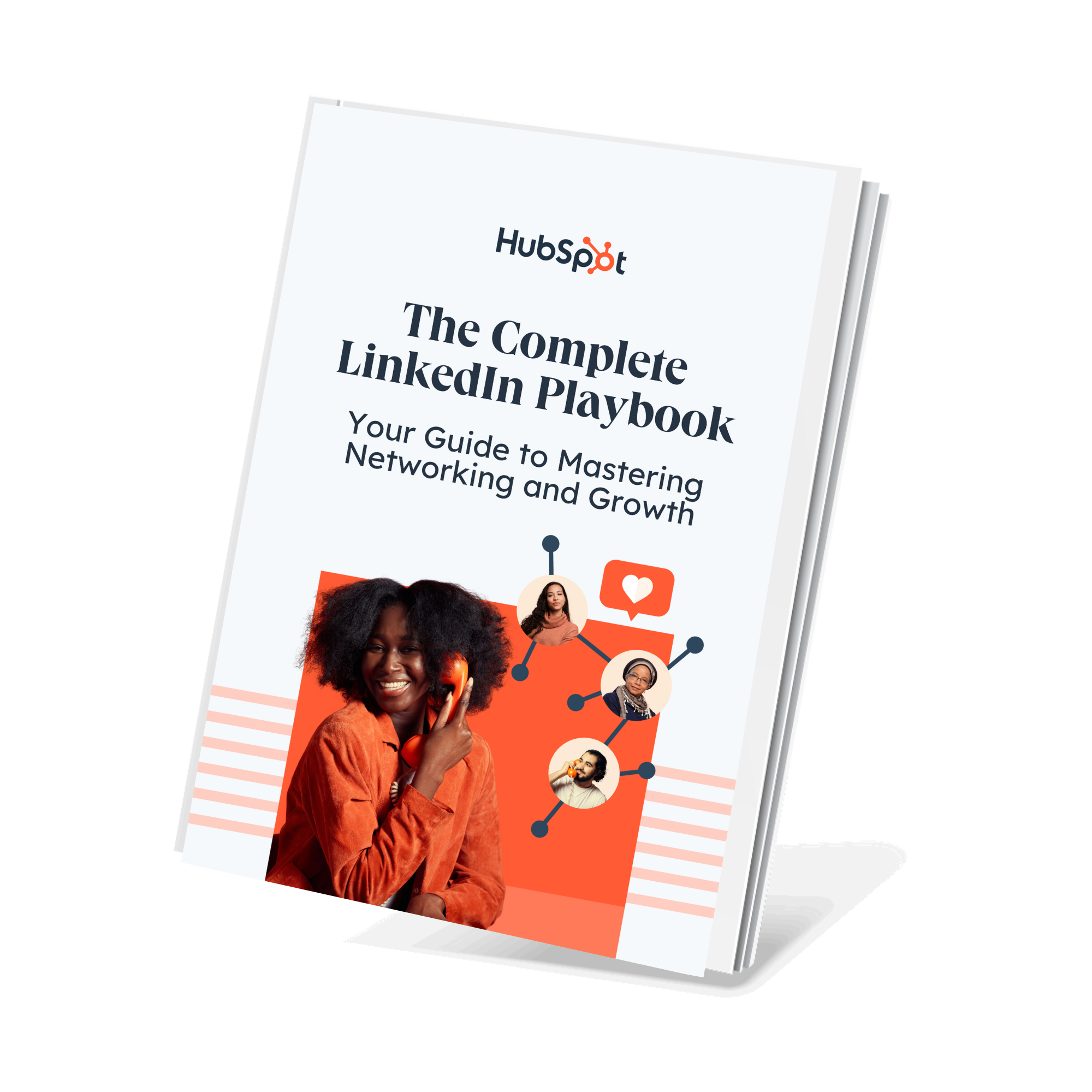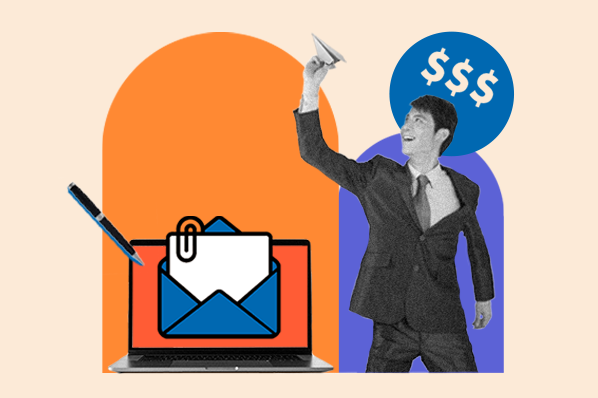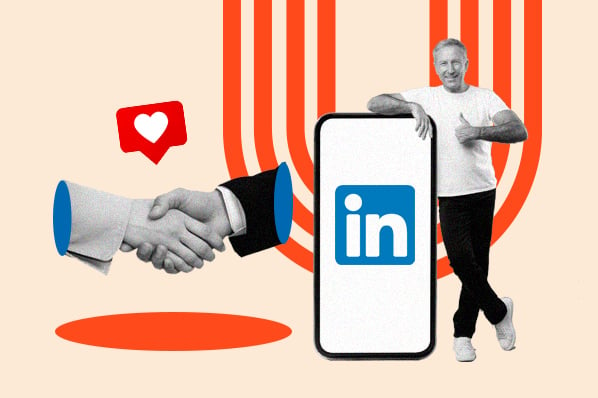The power of leveraging LinkedIn cannot be underestimated.
From job opportunities to guesting on podcasts, meeting people from all over the world, and having headhunters reach out with roles that take you to Chicago, Vegas, Berlin — it opens the door to a lifetime of adventures.
Valenta, Fortune, LinkedIn, CoachHub, and Experian were all jobs I landed through recruiter messages on LinkedIn.
Ready to learn how I did it? Let's dive in.
Table of Contents
- What is a LinkedIn headline?
- What should my LinkedIn headline say?
- 4 Tips on How to Write a LinkedIn Headline That Actually Stands Out
- LinkedIn Keywords List
- LinkedIn Keywords for a Headline
- How to Change Your LinkedIn Headline
- 20 LinkedIn Headline Examples
What is a LinkedIn headline?
A LinkedIn headline is the section at the top of a LinkedIn user's profile where they describe what they do in 220 characters or less. This brief description appears next to the user's name in search results. It should entice readers to click the profile to learn more about the user's experience and background.
Your headline is important for several reasons:
- It’s the first line LinkedIn users see on your profile.
- It gives an opportunity to show the world what you’re capable of and what you do.
- It influences someone’s first impression of you as they scroll through LinkedIn.
Letting LinkedIn choose your headline for you is a mistake. With a customized headline, you'll instantly distinguish yourself, give prospects and recruiters a reason to view your profile, and start building the case for your product.
Remember: A LinkedIn headline explains the value you’ll deliver as a future employee. You'd say that pay-off is worth the effort, right?
What should my LinkedIn headline say?
Having worked at LinkedIn and personally seen how powerful it can be for your career, I find it pretty incredible when you really sit with it and think about it. A simple website can make the difference between earning minimum wage — as I once did — and then, five years later, making the kind of money I never thought possible for someone who grew up poor, living on government assistance.
Here’s what I learned: At the end of the day, it's all about who people know, like, and trust. And your LinkedIn presence and profile can impact that.
A LinkedIn headline should:
- Describe what you do.
- Show why someone should connect with you.
- Imply how you can help them.
For example, when I started coaching SDRs and AEs, I changed my headline to “Sales Coach | Helping SDRs get promoted to Account Executive.” That shift alone sparked dozens of inbound leads.
The more specific you are, the more you will attract your ideal avatar. People think they might be turning away business with specificity, but the reality is that you want it to be clear so people know the audience you serve.
That being said:
A good headline captures someone’s attention, but what’s more important is your reputation. And that takes a lot of energy, effort, and cultivation.
The truth is that building a personal brand takes a lot of time and good will after decades of adding value to your community.
4 Tips on How to Write a LinkedIn Headline That Actually Stands Out
If you think about how much time professionals spend on LinkedIn, especially as a sales rep, it’s pretty mind-boggling. I spend more time on LinkedIn than I do sending emails or using any other apps. That is just the reality of the job.
After ten years of growing my own LinkedIn presence — and working at LinkedIn itself — I’ve learned that your headline is more than just a job title. It’s your first impression and your mini elevator pitch, all in one line.
Here’s what I’ve found works best.

1. Show what you do — and who you help.
Your headline should be clear, not clever. Don’t just write “Account Executive at Databricks” — add who you help and how. For example: “Trusted Advisor to CDO & CIOs to leverage their data to create business breakthroughs.”
Use the format in the template below, where X represents your ideal prospect, and Y is their ideal outcome or state of mind after connecting with you.

2. Use keywords your audience actually searches for.
Think like your ideal client, recruiter, or partner. What words would they type in? Sprinkle those keywords in naturally. This helps you show up in searches and makes the value you bring obvious.
There is always language that shows you are part of a tribe. For instance, you can’t go anywhere nowadays in tech sales without hearing pclub, SMB/MM/Ent, SaaS, AI, ML, Analytics, ARR, GTM. These help others show that you get it and you’re in that special tribe together.
3. Inject your personality or unique edge.
I also recommend you include interesting things in your headline that help connect with others — things like MBTI, CliftonStrengths Top 5, or anything that just humanizes you and gives others a reason to connect with you as an ice breaker.
4. Keep evolving it as you evolve.
Your headline isn’t set in stone. Update it as you grow, shift roles, or refine your niche. The version you wrote three years ago probably doesn’t reflect who you are today — and that’s okay. Changing it often will keep things interesting, as people will come and go from your life. It might give them a reason to catch up with you.
LinkedIn Keywords List
Using the right keywords in your LinkedIn profile is the key to getting more visitors who want to hire you or work with you. Similar to a resume, you want to draw eyes to the important aspects of your experience. While a resume uses keywords tailored to a specific job posting, a LinkedIn profile uses keywords tailored to your career expertise.
Recruiters, prospects, and the like will search for keywords related to the position they want to fill. Depending on what a searcher is looking for, one profile can appear on page one while another can appear on page eight. As someone who wants to be found, the keywords you use will directly impact whether you get in front of the right prospects. Here are some specific keyword areas to focus on:
- Job position and experience.
- Location.
- Skills and certificates.
- Services or products you offer.
- Name of your degree and field of study.
- General keywords related to your industry, field, or expertise.
It’s important to strike a balance between being concise but also broad enough to be found. For instance, instead of writing “Tech Leader” you might say, “Mobile Application Developer.” It’s specific enough to a job title yet broad enough for multiple recruiters in varying companies to find your profile.
LinkedIn Keywords for a Headline
Your headline for LinkedIn is no different than your profile in terms of using the right keywords to be discovered. However, the headline is arguably the most important part of your profile — it stops prospects from scrolling past your name to clicking on it.
A LinkedIn headline needs to use specific keywords to explain in a few words what you do and what you provide. This is why I think a customized headline is always better than the default LinkedIn headline.
Here are a few formulas you can use to write a great LinkedIn headline :
- (Title) at (Company) – Helping USP (Unique Selling Proposition)
- (Title) | (Company) | (USP)
- Title + Company + benefits of working with you | keywords related to your niche | personal touch |
Using one of the formulas above will elevate your LinkedIn headline and show prospects how you can add value to them. Now that you know how to choose keywords for your LinkedIn headline, let’s discuss how to change your LinkedIn headline to get your interview and job ready.
How to Change Your LinkedIn Headline
Updating your LinkedIn headline is incredibly simple. To better show how it’s done, I’ll update my own.
Step 1: Navigate to your profile.
If you’re new to LinkedIn, your profile is a blank canvas to be filled with everything that makes you great. Ensure your profile picture, experience, educational background, and skills are filled in before you optimize your headline.
Step 2: Click the edit icon.
At the top of your profile, beneath your banner, you’ll find a gray pencil symbol — the edit icon. Click on it, and it’ll open a window titled “Edit intro.”

Step 3: Select Heading and type in a new headline.
In the “Edit intro” window, after you have your name and pronouns added, you’ll find the “Headline” text box. Here, you’ll type in the attention-grabbing headline that accurately describes your title and goals.

Step 4: Click “Save,” and you’re done.
You’ll now be able to refresh your profile and see your new LinkedIn headline. When recruiters look at profiles in your industry and occupation, they’ll see a headline that catches their eye immediately.
Before you begin to work on your own headline, look at these examples for some extra inspiration.
20 LinkedIn Headline Examples
1. Highlight your job title and professional value.

I like how Taylor Rodriguez begins his headline by stating his position, “Marketing Strategist,” but indicates what his values are by including the descriptor “Community-Driven.” But he doesn't stop there. He goes on to explain exactly what he does as a marketing strategist.
He says he helps creators, coaches, and purpose-driven brands grow engaged audiences and beautiful websites. His mission and his value to viewers are clearly communicated.
Simply by reading his headline, I immediately understand the type of clients Rodriguez works with and the results he delivers. There’s no questioning his expertise or value in my mind.
Takeaway: Lead with your job title or role. Follow that up by naming your target market or client type. Then, drive it home by calling out the specific benefits and outcomes you help your clients achieve.
2. Highlight your niche and client experience.

Stephen Telford begins his headline with his value prop and an impressive stat. But where I think his headline really stands out is listing the specific services he offers to help people land jobs.
By naming particular services, Telford carves out his niche as a job coach and shows the concrete ways he helps his clients. It builds trust and clarifies how he can help potential clients.
Takeaway: Detail your services and who they’re tailored for to attract more qualified leads.
3. Make your headline digestible with separators.

Rana Bano’s headline is easy to digest. She’s packed a lot of information in there, but the vertical line separators make it simple for me to parse out the key elements.
Moreover, the words she has chosen are the keywords she wants to be found for. So her headline serves the dual purpose of easy readability plus findability for her keywords.
I also like how she includes her value proposition in her last point: “I make words work harder for your brand.”
Takeaway: When using separators, start with your current role and include keywords. Then you can add in notable past experiences, causes you advocate for, your value prop, or personal passions that relate to your work.
4. Be specific about who you help and how.

In his headline, Ian Tenenbaum speaks directly to entrepreneurs who struggle with ADHD who want to get organized, make a plan, and follow through.
I appreciate that Ian doesn’t try to be everything to everyone. By narrowing his focus to a specific group and a particular pain point, his headline packs a punch.
Takeaway: In just a few words, summarize who you help and the tangible results you deliver. Use specificity to inspire trust in your abilities.
5. Showcase your credibility with past experiences.

What catches my eye on Marcella Schlitt’s profile is the companies she has worked for. By mentioning her past experiences, Schlitt is letting me know that she’s honed her skills at some top businesses.
I’ve seen a lot of sales reps put things like “ex-Google,” “ex-Microsoft,” or “ex-Amazon” on their profiles, positions they eventually leave to work at a lesser-known brand. It might feel like a flex, but the reality is when you work at a top-tier company, you are more likely to be taken seriously. It’s the same as if you wear YSL, Christian Dior, people will automatically judge you, whether you like it or not. That’s just the reality of the world we live in.
The companies you work for give you street cred, so to speak. So don’t be afraid to share them up front like Schlitt does here. The brand names speak for themselves; no additions needed to her headline.
Takeaway: Weave in your past roles with top companies and use your background to showcase your credibility.
6. Convey your passion and purpose.

Terry Swack doesn’t just say she works on building projects. She specifies that she’s all about making it “super easy” to choose “greener and healthier products” for “high-performance, low-carbon” buildings. I can feel her commitment to sustainability and her drive to make a positive impact.
But what I love most is how she takes it a step further. Terry’s not just focused on the end result but also on rewarding the manufacturers who make these eco-friendly products possible. She recognizes that creating change takes a village, and she’s dedicated to supporting those who share her vision.
Takeaway: Like Terry, paint a vivid picture of your values and the change you’re working towards.
7. Clearly state your value proposition.

I like how Mattia Peretti’s headline tells prospects exactly how he can help them: understanding themselves, their audience, and their purpose. He puts his value prop front and center.
Instead of focusing on his achievements, past experience, or the details of his offerings, he puts the spotlight on his clients and the benefits he can provide for prospects.
Takeaway: Identify your niche, and then articulate the tangible value you offer in a way that’s clear, concise, and compelling.
8. Share a glimpse of your personal life.

I love how Heather Eason has created a well-rounded headline. She combines her professional roles with a touch of the personal, adding “Mom of 4 kids and 4 dogs.” These few words humanize her and also instantly create a relationship with other parents (and fur parents) on LinkedIn.
She surrounds her parental identity with her impressive professional experience, making each accomplishment stand out even more. This mix of professional and personal details makes her profile memorable and relatable.
Takeaway: Add a personal element to your headline to build a stronger connection with your network.
9. Keep it simple and straightforward.

Alnoor Pirani’s headline has a no-nonsense approach. In just a handful of words, Alnoor conveys his role and his company. I don’t need a lengthy description to understand what he does. “Scale through automation” tells me he’s in charge of working with agencies to automate their workflows.
Takeaway: Sometimes, less is more. Keep your headline concise and focused.
10. Include a CTA.

In his LinkedIn headline, Tom Orbach ends with a call-to-action, inviting viewers to try his newsletter along with his web address.
By placing his newsletter front and center, Orbach must be very confident that it will provide value to his prospects. He’s offering something to them before asking anything from them.
Takeaway: Use your LinkedIn real estate to point customers to your owned content (i.e., your website).
11. Make your words visual.

In just a few words, Aayushi Choudhary paints a picture of herself as a connector. The imagery of bridging a gap is compelling because it suggests a challenge that needs to be overcome. It positions Choudhary as someone who not only recognizes this challenge but is actively working to solve it.
But Aayushi doesn’t stop there. She goes on to list her current role, “Product @ Intelas,” and impressive past experiences, “Ex-Salesforce” and “CS Alum @ UTD.” By using the “@” symbol, she creates visual breaks that make her headline easy to scan and parse.
Takeaway: Combine a strong, evocative image with concrete details about your professional background.
12. Use emojis as meaningful separators.
![]()
Ellie Middleton uses emojis tastefully in her headline. She uses a relevant emoji before each phrase which I think grabs attention and enhances her headline while keeping it professional.
I appreciate that Middleton doesn’t rely solely on emojis to tell her story. Each section of her headline adds to a meaningful introduction that paints a picture of who she is.
Takeaway: Use emojis as separators and enhancers, but let the words do the heavy lifting.
13. Be friendly.

Trish Seidel’s headline really sets a friendly tone. The fact that she calls herself “Your marketing big sister” makes her seem friendly and helpful. This kind of headline invites people to connect and learn from her in a casual, supportive way.
I think the tone in her LinkedIn profile fits her brand voice, which is warm and friendly. If you go this route, make sure your voice fits you.
Takeaway: Add a personal touch like this to make yourself more accessible and welcoming.
14. Quantify your results.

When I see Amber Deibert’s headline, I immediately understand the unique value she brings to overwhelmed sellers. It’s a straightforward and quantifiable statement of how she can help her target audience.
What I appreciate most is the clarity and confidence of this headline. It doesn’t try to be everything to everyone but instead hones in on a specific value proposition for a defined audience.
Takeaway: Numbers build trust. Incorporate quantifiable achievements to build trust and credibility with potential clients.
15. Emphasize a unique leadership identity.

Tony Jamous identifies himself as a CEO who’s “Leading with Empathy & Mental Wellbeing,” which immediately sets him apart in business leadership.
His title highlights not only his successes but his leadership approach. This focus is especially appealing to stakeholders who prioritize ethical practices — and for anyone looking at Oyster as a company. Jamous’ work aligns with broader global impacts, so this positions him as a forward-thinking leader.
Takeaway: Create your headline to reflect the unique values and missions that define your leadership style.
16. Focus on the customer experience.

Mehakpreet Kaur highlights her services’ tangible benefits to a specific audience. Her target clients are founders, CEOs, VCs, and coaches — and she will help them monetize through her content and design skills.
I like how she defines her roles clearly and demonstrates broad yet specific skills, like lead generation and personal branding. Kaur’s headline makes it clear what she does and how it helps her clients.
Takeaway: Articulate the direct benefits your skills provide to your audience.
17. Use humor.

Erica Schneider’s headline is a great example of using humor to engage and connect with her audience.
“Running on seltzer 🤩” adds a personal and playful touch that makes her profile stand out. It humanizes her and makes her more relatable to potential clients.
Erica’s use of humor in her headline, alongside credentials like “Edited 3M+ words” and “Former Head of Content,” balances professionalism with personality.
Takeaway: Incorporate a bit of your personality or humor in your headline to engage your audience.
18. Mention your personal achievements.

John Bonini's LinkedIn headline does a great job of mixing professional details with a fun personal fact: “Shoots 85% from the free throw line.”
This bit of basketball trivia isn‘t just cool — it shows he’s got focus and precision, qualities you'd want in a consultant. Also, it makes him stand out and gives people an easy way to talk to him.
Takeaway: Throw in a personal achievement or hobby. It makes your profile more human and can be a great icebreaker.
19. Don’t be afraid to be silly.

Jacalyn Beales’s LinkedIn headline is a fun mix of her professional role and personal interests. She leads with “⚡️Leading lifecycle marketing @ Copy.ai,” which shows her expertise.
I love how she adds a twist with “On a mission to find the best Moscow Mule,” sharing her passion for a good drink. I also smiled at “Em dash enthusiast,” which shows Beales’s love for punctuation quirks. It‘s a headline that’s professional yet personal, making her profile stand out.
Takeaway: Think about any quirky goals you can add to make your profile more memorable.
20. Integrate brand messaging for impact.

Dharmesh Shah’s headline, “Helping millions grow better,” incorporates HubSpot’s own branding into his personal profile. He aligns herself with HubSpot’s values and emphasizes the direct benefits he has brought through co-founding HubSpot.
By using the phrase “Grow Better,” which is part of HubSpot’s customer code, he communicates a promise of value and commitment to potential clients and partners.
Takeaway: Consider how you can weave your organization’s brand messages into your headline to reinforce your role and value.
A powerful LinkedIn headline is a game-changer.
At the end of the day, your LinkedIn headline is one of the most powerful lines you’ll ever write about yourself — and I say that as someone who’s spent over a decade growing my presence there.
Whether you’re looking for a new job, new clients, or just building meaningful connections, your LinkedIn headline is the first signal to the world about who you are, who you help, and why they should care.
Experiment and try different things. It might feel like a small tweak, but those small tweaks lead to opportunities you could have never imagined ten years ago. I’ve landed life-changing career opportunities, received podcast guest invites, and cultivated friendships and mentorships just because people knew exactly what I stood for and who I served.
So take the time to make your headline clear, keyword-rich, specific, and true to you.
And remember — LinkedIn is a living, breathing network. Keep showing up, keep adding value, and keep evolving.
The right people will find you. I promise.
Social Selling on LinkedIn



![15 Best LinkedIn Summary & Bio Examples [+ How to Write Your Own]](https://53.fs1.hubspotusercontent-na1.net/hubfs/53/linkedin-summary-examples-4.jpg)



.jpg)

![How to Write InMail Messages to Recruiters on LinkedIn [Samples + Templates]](https://53.fs1.hubspotusercontent-na1.net/hubfs/53/how-to-craft-an-inmail-that-gets-results-1.jpg)


![LinkedIn Prospecting Messages: How to Nail One [+ Templates]](https://53.fs1.hubspotusercontent-na1.net/hubfs/53/Linkedin%20prospecting%20messages%20(1).webp)